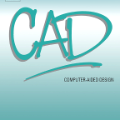We propose a Point-Voxel DeConvolution (PVDeConv) module for 3D data autoencoder. To demonstrate its efficiency we learn to synthesize high-resolution point clouds of 10k points that densely describe the underlying geometry of Computer Aided Design (CAD) models. Scanning artifacts, such as protrusions, missing parts, smoothed edges and holes, inevitably appear in real 3D scans of fabricated CAD objects. Learning the original CAD model construction from a 3D scan requires a ground truth to be available together with the corresponding 3D scan of an object. To solve the gap, we introduce a new dedicated dataset, the CC3D, containing 50k+ pairs of CAD models and their corresponding 3D meshes. This dataset is used to learn a convolutional autoencoder for point clouds sampled from the pairs of 3D scans - CAD models. The challenges of this new dataset are demonstrated in comparison with other generative point cloud sampling models trained on ShapeNet. The CC3D autoencoder is efficient with respect to memory consumption and training time as compared to stateof-the-art models for 3D data generation.
翻译:我们为 3D 数据自动解码器建议了一个点- Voxel Deconvolution (PVDeConv) 模块。 为了展示其效率, 我们学会合成高分辨率点云层, 共10千点, 高密度描述计算机辅助设计模型(CAD) 的基本几何。 扫描文物, 如外形、 缺失的部件、 平滑的边缘和孔, 必然出现在伪造 CAD 对象的真实的 3D 扫描中。 从 3D 扫描中学习原始 CAD 模型的构建需要与对应的 3D 对象扫描一起提供地面真实性。 为了解决空白, 我们引入了一个新的专用数据集, CC3D, 包含50k+ 双 CAD 模型及其对应的 3D 片断。 该数据集用于学习3D 扫描对象的点云的导出带的进动自动解码。 与 ShapeNet 培训的其他基因化点云采样模型相比, 新数据集的挑战得到了证明。 CC3D 自动解算器在记忆消耗和培训时间方面的效率, 与 3D 数据生成模型与 StateD 的模型比较。




